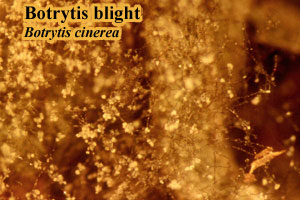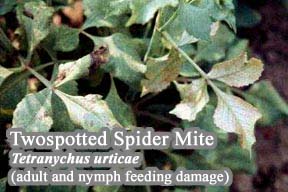Ageratum (Ageratum)
Plant Health Problems
Diseases caused by Fungi:
Root rot, Pythium, Rhizoctonia, Fusarium.
Symptoms appear as wilting, stunting, and general droopiness of the foliage
and are non-specific. This flaccid appearance is often accompanied by browning
and rotting of the roots and the crown. Yellowing and death of the outer leaves
follows until finally the entire plant collapses and dies. The fungi associated
with root rots are soilborne organisms that can persist in the soil for many
years.
Control can be achieved by maximizing plant vigor by careful watering and
fertilizing. It is also helpful to locate the plants in different areas of the
garden using crop rotation. Highly symptomatic plants can be rogued and removed
since recovery is unlikely. Fungicides are not effective for control.
 Botrytis blight, Botrytis cinerea.
Botrytis blight, Botrytis cinerea.
Flowers turn a papery brown and become covered with gray, fuzzy masses.
Senescing flowers are particularly susceptible. Tan to brown spots with a
target-like appearance can also develop on the leaves. These patches are often
associated with flowers which have dropped onto the leaf surface. This disease
is particularly troublesome during periods of extended cloudy, humid, wet
weather.
Good sanitation practices including grooming the plants and removing spent or
senescing flowers can minimize the potential for infection. These affected tissues
should be carefully removed and discarded when they are dry. It is also
important to avoid wetting the flowers when watering and crowding plants.
Adequate spacing between the plants can promote good air circulation. Control
can also be achieved with the use of fungicide sprays applied as soon as
symptoms are visible. Among the compounds registered for use in Connecticut are
chlorothalonil, mancozeb, and thiophanate-methyl. Consult the label for dosage rates and safety
precautions.
Insect Problems:
Greenhouse orthezia, Orthezia insignis.
This insect is a common pest of ageratum in greenhouses. This is a dark-green
or brown scale-like insect that secretes wax as it feeds, leaving behind a long
plate of white wax. It damages plants by withdrawing sap. When needed, malathion,
which is among the compounds registered for control of this pest in
Connecticut, can be applied according to label directions.
Mealybugs, Planococcus citri.
Ageratum plants in greenhouses are often infested with mealybugs. White cottony
masses appear on leaf surfaces, in leaf axils and sheaths. These insects damage
plants by sucking plant sap. Among the compounds registered for control of this
pest in Connecticut are insecticidal soap, ultrafine horticultural oil or
resmethrin. These products are most effective against crawlers. Because of
overlapping life stages in a home environment, multiple applications will be
needed to control this pest. Spray needs to contact the insect. Alternatively,
use imidacloprid as a drench to be taken up as a systemic by the roots. Consult
the label for dosage rates and safety precautions.
 Twospotted spider mite, Tetranychus urticae.
Twospotted spider mite, Tetranychus urticae.
Spider mites infest the undersides of the leaves, which become light yellow in
color, and the plants have a generally unhealthy appearance. Sometimes the
mites form webs, which more or less enclose the upper as well as the lower leaf
surface. Among the compounds registered for control of this pest in Connecticut
are insecticidal soap and ultrafine horticultural oil. Spraying with
insecticidal soap will give sufficient control if applied at least twice at
7-10 day intervals. The predatory mite, Neoseiulus fallacis, is most
commonly found feeding where there are mite infestations. A single application
of ultrafine horticultural oil (1% dilution) can be effective if predatory
mites are present. Special care should be taken with soap or oil to obtain
thorough spray coverage, because they only work on contact. Abamectin is an
effective restricted use material. Consult the label for dosage rates and safety
precautions. Avoid applying carbaryl or pyrethroids, which tend to be much more
toxic to the predators than to the pest spider mites.
Whiteflies, Trialeurodes vaporariorum.
The greenhouse whitefly, Trialeurodes vaporariorum, the sweetpotato
whitefly, Bemisia tabaci, and silverleaf whitefly, Bemisia
argentifolii, commonly infest many kinds of plants grown under glass and
are often carried into the field where they may persist. The life cycles of
these species are similar. The tiny, white moth-like adult has a mealy
appearance due to the small particles of wax that it secretes. It lays groups
of eggs on the underside of leaves. The eggs hatch into small oval crawlers,
which then settle down and become scale-like nymphs that suck sap from
stationary locations on the leaves. These then spend about 4 days in an
immobile pupal stage before becoming adults. About 5 weeks are required to
complete the life cycle in the greenhouse.
Yellow sticky traps are an effective way to monitor populations of whiteflies,
and may even be attractive enough to reduce minor infestations. Biological
controls can also be effective against whiteflies, especially in a greenhouse
environment. The predatory ladybeetle, Delphastus pusillus, specializes
in whiteflies and feeds on all three whitefly species. The parasitoid,
Encarsia formosa, can control the greenhouse whitefly, but not the other
species, in the greenhouse. Another parasitoid, Eretmocerus californicus,
attacks all three species and can assist in controlling minor infestations in
the greenhouse. Insecticidal soap or ultrafine horticultural oil, which are
among the compounds registered for control of this pest in Connecticut, sprayed
on the undersides of leaves, can be used against whiteflies in the greenhouse
or the field. When applied at a low, half-percent concentration, soap is
selectively toxic to whiteflies rather than parasitic wasps. Azadiractin (neem)
and fenoxycarb, also directed to the undersides of the leaves, act as insect
growth regulators and can also be used. Repeat applications of sprays will
probably be needed because insecticides do not kill some stages in the life
cycle. Imidacloprid can be applied as a systemic to be taken up by the roots.
Consult the label for dosage rates and safety precautions. Chemical control
using conventional insecticides is difficult because of widespread insecticide
resistance.

